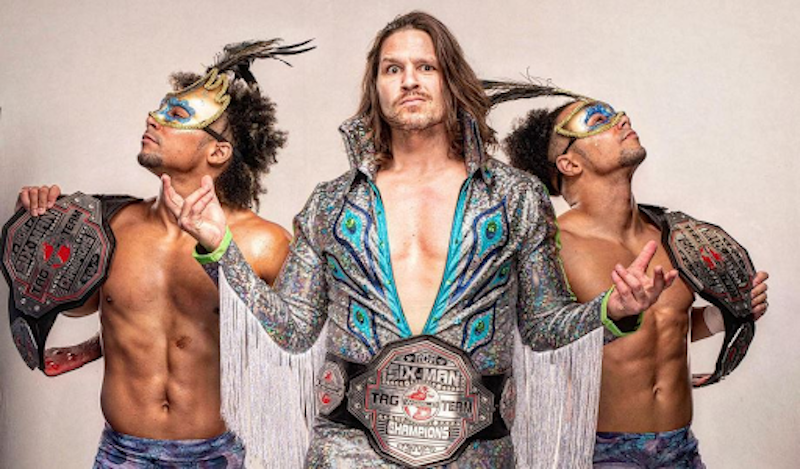In the world of professional wrestling, where giants and pretty boys reign supreme, Dalton Castle remains an enigmatic figure, a gutwrench-suplexing, peacock-strutting, and girdle-wearing embodiment of Wilco's "The Late Greats"—a catchy song that describes an extraordinary yet unconventional talent who, despite his brilliance, hovers outside the limelight of mainstream superstardom.
Castle, born Brett Giehl, is more than just a pro wrestler; he's a performance artist whose carefully-crafted persona is equal parts flamboyance, strength, and skill. His approach to wrestling transcends mere athleticism, blending his high-level amateur wrestling background with a theatrical, boy-loving gimmick that makes him a standout. Ironically, it's this uncomfortable blend that perhaps keeps him from becoming a household name like his WWE or AEW counterparts—how can you be both tough guy and dandy, expert grappler and deranged lunatic who tosses his own Boys (5’6” twins Brandon and Brent Tate) at foes. Castle's character work, reminiscent of an earnest lounge singer, captivates with a certain sleaze and delight, akin to an artist committed to his craft, despite the majority of his audience never fully grasping the act.
His in-ring prowess, owing to his amateur wrestling roots, translates into performances that are technically sound and visually compelling. Castle's style, combining strength and technical finesse, is often underappreciated in an industry sometimes inclined towards more straightforward brawling or high-flying styles. His signature entrance—in which he’s fanned and feted by his Boys, all the while cutting an unhinged promo about whichever opponent he’s facing—and flamboyant persona make every appearance an event, a blend of weird energy and physical dominance that adds an intriguing layer to his character. Even when he’s far from the main event, as he was at the Ring of Honor taping I attended in Pittsburgh last week, he sells, emotes, and throws like he’s main-eventing WrestleMania.
Despite his undeniable talent and top-notch character work, Castle remains a divisive figure appreciated mainly by a subset of hardcore wrestling aficionados—a "total package of a package no one cares about," to quote a phrase resonating with those who understand the nuances of wrestling performance. His social media presence, quirky and engaging, garners attention but certainly not at the scale expected for someone of his caliber, a former world champion in a promotion that was once arguably the third highest-profile in the US. Nor does he carry himself like a stuck-up star, instead delivering the same level of high-energy performance irrespective of the audience size—bad marketing, yet a testament to his commitment to his craft.
Castle's journey mirrors the phenomenon described in "The Late Greats," wherein his look, style, and persona don't fit the conventional mold of mainstream superstars—yet it’s precisely these attributes that make him so compelling to spectators like me. This isn’t unique to wrestling; many artists, musicians, and performers revered in niche circles never achieve much fame. Castle, with his charisma, technical skill, and offbeat character, fits this mold perfectly.
His story starts early, influenced as a boy by icons like "Macho Man" Randy Savage, Curt Hennig, and Davey Boy Smith. These early influences are evident in his vibrant ring presence and technical skill. Castle's amateur wrestling experience, spanning more than a decade from middle school through college, laid the groundwork for his unique blend of athleticism and theatricality.
The wrestling character he created from this matrix—colorful 1980s WWF wrestling, freestyle and Greco-Roman training—is a study in contrasts: a flamboyant personality coupled with serious in-ring ability. He strikes a balance between authentic shooter and cartoon character, ensuring his portrayal is never seen as hackneyed—perhaps to his detriment, in a field where easy-to-understand personas are much more marketable. In the wrestling world, Castle remains best known for his time in ROH, where he was a one-time ROH World Champion and World Television Champion—and still works there to this day, producing filler material for owner Tony Khan’s streaming service and only materializing on AEW television to “do the job” for bigger names like Chris Jericho.
In spite of the accolades he’s racked up—he was the subject of many a long magazine profile back in the mid-2010s, when publications like Rolling Stone and VICE were chasing engagement with all kinds of content—his life has been fraught with challenges. His feud with Rush, culminating in a loss at Summer Supercard, and his subsequent heel turn exemplify the continuous evolution of his career, even if it never seems like he’s made any upward progress.
Castle's impact on wrestling should’ve been profound, yet my hunch is that he’ll wind up forgotten not long after he hangs up the sparkly trunks beneath which he wears a bulky brace necessitated by recurring back injuries from the impressive no-momentum lifts he performs in the ring. Now 37, he’ll never headline a show at a football arena or luck into the sort of wild audience response of someone like fellow outside-the-mainstream grinder Shaun Ricker, who is now main-eventing in WWE as “LA Knight” on the strength of his streamlined, dumbed-down, and thoroughly entertaining Attitude Era-style promos. LA Knight is as digestible as warm oatmeal, a catchy indie cover of a hard rock staple; Castle, meanwhile, is more closely akin to a misguided auteur’s melding of Lou Reed’s Metal Machine Music with the dulcet tones of Tiny Tim. Castle, ever the “old trouper,” will keep trading wins and losses just outside of view, content to show off superstar talent that has never once paid superstar dividends in the sport he loves so dearly.

